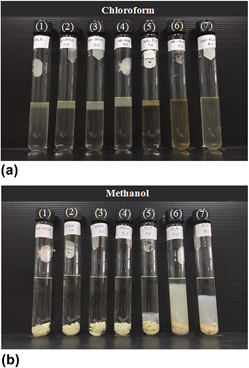Crossref Citations
This article has been cited by the following publications. This list is generated based on data provided by
Crossref.
Qian, Shaoping
Tao, Yingying
Ruan, Yiping
Fontanillo Lopez, Cesar A.
and
Xu, Linqiong
2018.
Ultrafine bamboo-char as a new reinforcement in poly(lactic acid)/bamboo particle biocomposites: The effects on mechanical, thermal, and morphological properties.
Journal of Materials Research,
Vol. 33,
Issue. 22,
p.
3870.
Maroufkhani, Mahshid
Katbab, AliAsghar
and
Zhang, Jinwen
2018.
Manipulation of the properties of PLA nanocomposites by controlling the distribution of nanoclay via varying the acrylonitrile content in NBR rubber.
Polymer Testing,
Vol. 65,
Issue. ,
p.
313.
Phromma, Warangkhana
and
Magaraphan, Rathanawan
2018.
Fabrication of Admicelled Natural Rubber by Polycaprolactone for Toughening Poly(lactic acid).
Journal of Polymers and the Environment,
Vol. 26,
Issue. 6,
p.
2268.
Lu, Xun
Yang, Yilin
Cheng, Bo
and
Li, Tao
2018.
High damping epoxized natural rubber/diallyl adiallyl phthalate prepolymer (ENR/DAP‐A) blends engineered by interphase crosslinking.
Journal of Applied Polymer Science,
Vol. 135,
Issue. 23,
Mat Desa, Mohd Shaiful Zaidi
Hassan, Azman
Arsad, Agus
Yusop, Masleeyati
and
Abd Jalil, A.
2019.
Dynamic mechanical properties and morphology characteristics of rubber-toughened poly(lactic acid).
E3S Web of Conferences,
Vol. 90,
Issue. ,
p.
01001.
Boochathum, P
Mingwanish, W
and
Pivsa-Art, S
2019.
Impact strength enhanced bioplastic polylactic acid by interfacial bonding with hydroxylated natural rubber.
IOP Conference Series: Materials Science and Engineering,
Vol. 526,
Issue. 1,
p.
012039.
Klinkajorn, Jenjira
and
Tanrattanakul, Varaporn
2020.
The effect of epoxide content on compatibility of poly(lactic acid)/epoxidized natural rubber blends.
Journal of Applied Polymer Science,
Vol. 137,
Issue. 34,
Chalid, Mochamad
Husnil, Yuli Amalia
Puspitasari, Santi
and
Cifriadi, Adi
2020.
Experimental and Modelling Study of the Effect of Adding Starch-Modified Natural Rubber Hybrid to the Vulcanization of Sorghum Fibers-Filled Natural Rubber.
Polymers,
Vol. 12,
Issue. 12,
p.
3017.
Tessanan, Wasan
Chanthateyanonth, Ratana
Yamaguchi, Masayuki
and
Phinyocheep, Pranee
2020.
Improvement of mechanical and impact performance of poly(lactic acid) by renewable modified natural rubber.
Journal of Cleaner Production,
Vol. 276,
Issue. ,
p.
123800.
Zhang, Qingfa
Lei, Hanwu
Cai, Hongzhen
Han, Xiangsheng
Lin, Xiaona
Qian, Moriko
Zhao, Yunfeng
Huo, Erguang
Villota, Elmar M.
and
Mateo, Wendy
2020.
Improvement on the properties of microcrystalline cellulose/polylactic acid composites by using activated biochar.
Journal of Cleaner Production,
Vol. 252,
Issue. ,
p.
119898.
Alias, N. F.
Ismail, H.
and
Marsilla, K. I. K.
2020.
The effect of type of rubber and kenaf loading on water absorption, impact properties and morphology of polylactic acid/rubber/kenaf biocomposite.
Vol. 2267,
Issue. ,
p.
020011.
Harris, Muhammad
Potgieter, Johan
Mohsin, Hammad
Chen, Jim Qun
Ray, Sudip
and
Arif, Khalid Mahmood
2021.
Partial Polymer Blend for Fused Filament Fabrication with High Thermal Stability.
Polymers,
Vol. 13,
Issue. 19,
p.
3353.
Burkov, Andrey
Kraev, Alexander
Grishin, Maxim
Vesnin, Roman
Fomin, Sergey
and
Iordanskii, Alexey
2021.
Structural Features and Properties’ Characterization of Polylactic Acid/Natural Rubber Blends with Epoxidized Soybean Oil.
Polymers,
Vol. 13,
Issue. 7,
p.
1101.
Nitiyah, K.K.
Musa, Luqman
Rasidi, M.S.M.
Rahim, Shayfull Zamree Abd
Rahman, Rozyanty
Azmi, Ahmad Azrem
and
Rennie, Allan
2021.
A review on graft compatibilizer for thermoplastic elastomer blend.
Journal of Physics: Conference Series,
Vol. 2080,
Issue. 1,
p.
012003.
Bhola, Shivam
Arora, Kanika
Kulshrestha, Saurabh
Mehariya, Sanjeet
Bhatia, Ravi Kant
Kaur, Parneet
and
Kumar, Pradeep
2021.
Established and Emerging Producers of PHA: Redefining the Possibility.
Applied Biochemistry and Biotechnology,
Vol. 193,
Issue. 11,
p.
3812.
de Almeida, Janaína Fernandes Moreno
de Oliveira, Amanda Gerhardt
de Sousa, Ana Maria Furtado
Fernandes, Teresa Maria Dias
Bertolino, Luiz Carlos
Pacheco, Elen BA Vasques
and
da Silva, Ana Lúcia Nazareth
2021.
Toughness improvement of poly(lactic acid) by the addition of pre-crosslinked powdered nitrile rubber/CaCO3 for thermoforming molding.
Journal of Elastomers & Plastics,
Vol. 53,
Issue. 6,
p.
565.
Masek, Anna
Cichosz, Stefan
and
Piotrowska, Małgorzata
2021.
Biocomposites of Epoxidized Natural Rubber/Poly(lactic acid) Modified with Natural Fillers (Part I).
International Journal of Molecular Sciences,
Vol. 22,
Issue. 6,
p.
3150.
Masek, Anna
and
Cichosz, Stefan
2021.
Biocomposites of Epoxidized Natural Rubber/Poly(Lactic Acid) Modified with Natural Substances: Influence of Biomolecules on the Aging Properties (Part II).
Polymers,
Vol. 13,
Issue. 11,
p.
1677.
Srisuwan, Sawitri
Ruksakulpiwat, Yupaporn
and
Chumsamrong, Pranee
2021.
Effect of triblock copolymers based on liquid natural rubber and low molecular weight poly(lactic acid) on physical properties of poly(lactic acid)/natural rubber blend.
Polymer Bulletin,
Vol. 78,
Issue. 3,
p.
1253.
Jaratrotkamjorn, Ruedee
and
Tanrattanakul, Varaporn
2021.
Toughness improvement of poly(lactic acid) with poly(vinyl propionate)‐grafted natural rubber.
Journal of Applied Polymer Science,
Vol. 138,
Issue. 38,






